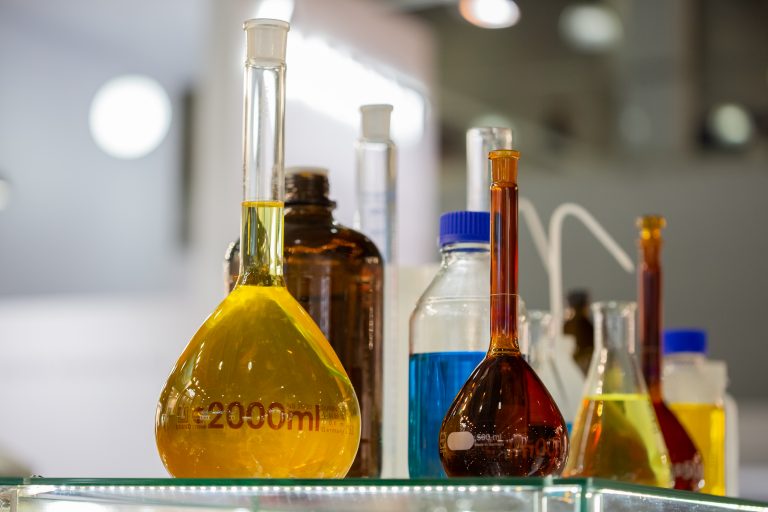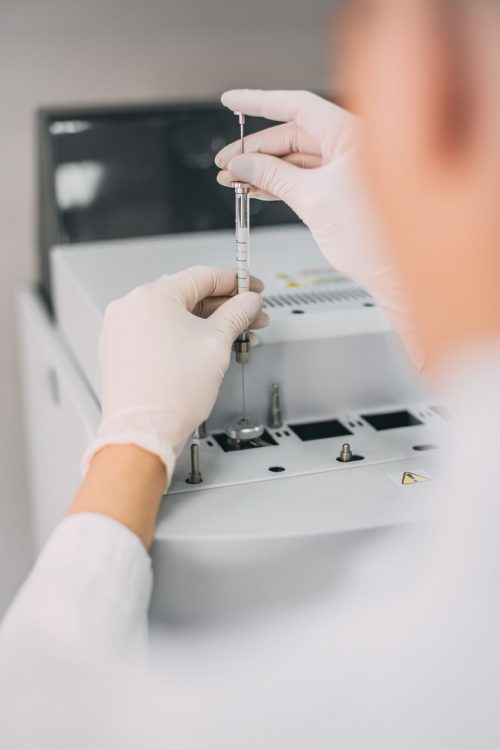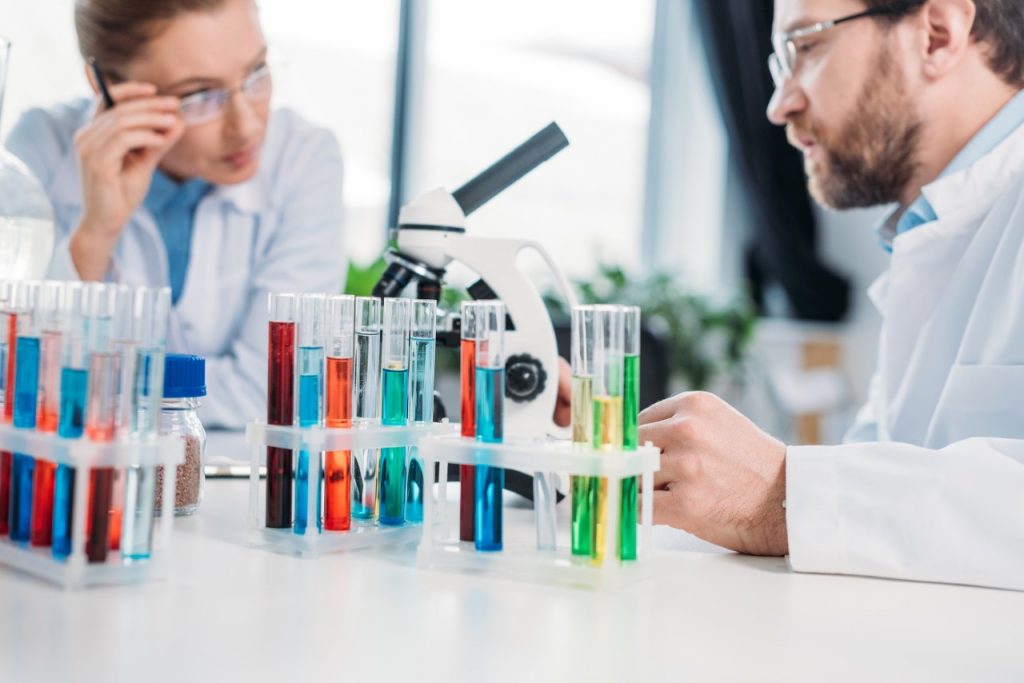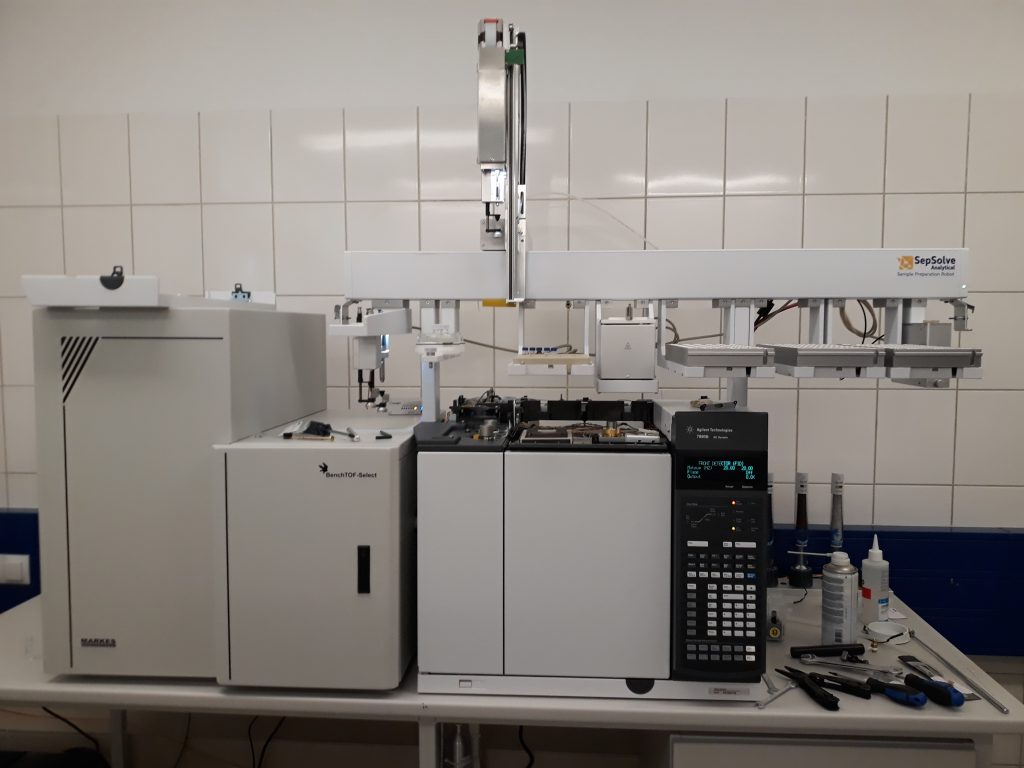Department of Chemistry
Head of the Department of Chemistry
dr hab. Agata Górska, prof. SGGW
Tel. (22) 59 37 613
Secretariat
mgr inż. Agnieszka Krzyczkowska
Tel. (22) 59 37 635
e-mail: kc@sggw.edu.pl

Employees
Dr hab. inż. Joanna Bryś, prof. SGGW
Dr inż. Rita Brzezińska
Dr Beata Dasiewicz
Dr inż. Katarzyna Dobrosz-Teperek
Dr hab. Agata Fabiszewska, prof. SGGW
Marzenna Filipczuk
Mgr inż. Janina Gaworska
Dr hab. Agata Górska, prof. SGGW
Dr inż. Agnieszka Górska
Dr hab. inż. Eliza Gruczyńska-Sękowska
Dr Beata Just-Brochocka
Dr Beata Kamińska
Prof. dr hab. Piotr Koczoń
Dr Dorota Kowalska
Dr hab. Mariola Kozłowska, prof. SGGW
Mgr inż. Agnieszka Krzyczkowska
Dr Ewa Majewska
Dr inż. Jolanta Małajowicz
Dr Diana Mańko-Jurkowska
Dr hab. inż. Ewa Ostrowska-Ligęza, prof. SGGW
Dr inż. Bożena Parczewska-Plesnar
Prof. dr hab. Ewa Raczyńska
Dr inż. Katarzyna Tarnowska
Dr hab. inż. Magdalena Wirkowska-Wojdyła
Dr inż. dr inż. Bartłomiej Zieniuk
Dr inż. Katarzyna Wierzchowska
Dr Iga Piasecka
Pracownicy emerytowani
prof. dr hab. Ewa Białecka-Florjańczyk
prof. dr hab. Andrzej Orzeszko
dr inż. Witold Bekas, prof. SGGW
dr Paweł Bukowski
dr inż. Wanda Kosińska
dr Grażyna Orzeszko
dr Ewa Rostkowska-Demner
dr Andrzej Sadownik
dr Sylwester Stępniak
dr Ewa Więckowska-Bryłka
Anna Borkowska
Irena Nejmanowska
Doktoranci
Research
⦁ Research in the field of thermal analysis using Differential Scanning Calorimetry (DSC), Pressure Differential Scanning Calorimetry (PDSC) and Thermogravimetry (TGA).
⦁ Research on transformations and their thermal effects in lipids and other macromolecular compounds.
⦁ Proton transfer reactions in biomolecules and their model compounds. Acid-base equilibria for biomolecules and model compounds.
⦁ Spectroscopic research and theoretical calculations.
⦁ Biotransformations with yeast: synthesis of fragrances, detergents and antioxidants.
⦁ Research on the use of the ability of microorganisms to synthesize enzymes in agricultural biotechnology, food and medicine.
⦁ Research on the effective use of yeast biomass as catalysts for chemical reactions.
⦁ Research on the physicochemical properties of vegetable and animal fats.
⦁ Modifications of natural fats.
⦁ Research on fermentation and oxidation processes.
⦁ Spectroscopic studies (UV, IR) of chemical compounds present in food.
⦁ Calorimetric research, gas chromatography.
⦁ Determination of polyphenols and antioxidant activity in fats and plant extracts.

Didactics
Analytical Chemistry
Physical Chemistry
General and Inorganic Chemistry
Organic Chemistry
Food Chemistry
Chemistry of Natural Compounds with Elements of Enzymology
Green Chemistry in the Food Industry
Instrumental Methods for Assessing Food Safety and Quality
Enzyme Preparation Technology
Subjects taught in English:
Chemistry
Carcinogens in food
Alcoholic beverages and human being
Instrumental methods for biological sample (mixture) analysis
Drugs, medicines and smart food components and additives

Cooperation with the environment
Consultation and analytical research (including spectroscopic, calorimetric, chromatographic (gas chromatography) and classical analysis) in the field of food chemistry.
Consultation and research in the field of thermal analysis using Differential Scanning Calorimetry (DSC), Pressure Differential Scanning Calorimetry (PDSC) and Thermogravimetry (TGA).
IR and UV spectra – experimental recording and theoretical calculations.
Optimization of waste management processes in the food industry.
Determination of polyphenols and antioxidant activity in fats.
Determination of the energy value of food products and organic materials with the use of oxygen. Measurement with a calorimetric bomb.
Thermal characteristics of various types of products. Measurement with DSC (Differential Scanning Calorimeter). Thermal analysis takes place in special aluminum or copper vessels closed hermetically or non-hermetically with the use of oxygen and nitrogen (separately), temperature range -90 to 700 ° C, heating/cooling rate 5 °C/minute.

Glass transition (phase transition temperatures). Measurement using a modulated differential scanning calorimeter (MDSC). Temperature range -90 to 700 °C, special aluminum vessels with hermetic lids – crimping the vessels, operation with nitrogen, proper arrangement of the material in the vessel, heating/cooling rate 1-2 °C/minute
Determination of heat capacity and its changes, enthalpy of changes and chemical reactions. Measurement by DSC. Thermal analysis in special aluminum vessels closed hermetically or non-hermetically with nitrogen, temperature range -90 to 700 °C, heating/cooling rate 2-10 °C/minute.
Determination of specific heat, melting point and crystallization point for organic materials. Measurement by DSC. Thermal analysis in special aluminum vessels hermetically sealed with nitrogen, temperature range -90 to 700 °C, heating rate 1 °C/minute.
Determination of the softening characteristics for edible oils and fats. Measurement by DSC. Thermal analysis in special aluminum vessels hermetically sealed with nitrogen, temperature range -80 to 80 °C, heating rate 2-10 °C/minute.
Determination of polymorphic transformations and modification of rheological properties for edible oils and fats, identification and determination of fat adulteration. Measurement by DSC. Thermal analysis in special aluminum vessels hermetically sealed with nitrogen, temperature range -90 to 700 °C, heating rate 1-2 °C/minute.
Assessment of fat resistance to thermal decomposition – determination of the initial temperature and maximum temperature of the oxidation process. Measurement with PDSC – Pressure Differential Scanning Calorimeter. Operation with oxygen, aluminum cells open, temperature range 30-700 °C. Heating rate 1.5-20 °C/minute. Atmospheric pressure – 113hPa.
Determination of the activation energy of edible oils and fats, the pre-power factor of edible oils and fats, constant rate of the oxidation reaction of edible oils and fats. PDSC. Operation with oxygen, aluminum cells open, temperature range 30-700 °C. Heating rate 1.5-20 °C/minute. Atmospheric pressure – 113hPa.
Determination of the fat oxidation times by the PDSC method (isothermal conditions). Temperature range 90-150 °C. Pressure – 1400kPa, open aluminum vessels, work with oxygen.
Determination of the weight loss of organic substances depending on the temperature. Measurement with a thermogravimetric thermal analyzer. Temperature range 50-1000 °C, work with nitrogen or oxygen – atmospheric pressure, special platinum vessels with a ceramic frit on the handle. Determination of infrared spectra of food substances and other substances occurring in various states of aggregation, i.e. liquids, solids and pastes. Determination with FT-IR spectrometer.
Determination of fatty acid composition in vegetable and animal fats by chromatographic method (GC). For the determination of fatty acid methyl esters, the apparatus YL6100 with FID detector, equipped with a capillary column filled with the BPX 70 stationary phase, is used, nitrogen is used as the carrier gas.
Determination of β-carotene in food products by chromatographic method (HPLC) after extraction with hexane.
The chromatographic analysis is performed using a Dionex kit with a UV-VIS detector (Agilent 1200). The separation is performed on an Onyx Monolithic C18, 100 x 4.6 column (Phenomenex). The mobile phase is acetonitrile and a mixture of methanol and ethyl acetate.
Cooperation with the socio-economic environment
- Cooperation with the company Sante A. Kowalski under the cooperation agreement CIiTT/36/2013.
- Cooperation with the enterprise WITPOL Sp. z o.o. under the cooperation agreement CIiTT/125/2014.
- Cooperation with Laboratory of Research on Feminine Milk and Lactation of the Medical University of Warsaw
- Cooperation with the enterprise Bakoma Sp. z o.o.
- Cooperation with the company Sosta Sp. z o.o. under the cooperation agreement CIiTT/43/2019.
- Cooperation with Poznań University of Life Sciences
- Cooperation with Institute of Biotechnology and Agricultural and Food Industry in Warsaw.
- Cooperation with the University of Zagreb in Croatia.
Offer for schools and teachers
- Lectures and exercises in general and inorganic chemistry for postgraduate students.
- Exercises and workshops in general, inorganic, organic and food chemistry for secondary school students.
Apparatus
- Dionex HPLC chromatograph with 3 detectors (RF 2000 FLUORESCENCE, UVD 170S, ESA)
- GC YL6100 chromatograph
- TG DISCOVERY thermogravimeter with the mass spectrometer
- PDSC TA Instruments Q200 (differential pressure scanning calorimeter) and DSC TA Instruments Q20 (differential scanning calorimeter)
- Calorimetric bomb with a computer.
- PERKIN-ELMER LAMBDA spectrophotometer 11
- Rayleigh UV1601 spectrophotometer
- MPW centrifuges
- FT-IR PERKIN-ELMER
- Chromatograph suitable for complete two-dimensional gas chromatography (manufacturer: Agilent Technologies, type: GC 7890B) with a time-of-flight mass spectrometer (TOF MS, manufacturer: Markes International, type: BENCH TOF-Select GCXGX TOF MS) and an automatic sample preparation and feeding station (autosampler) (manufacturer: CTC, type: PAL 3 RTC)
- Rotavapor® Essential vacuum distillation set with a vacuum pump, vacuum controller and circulation thermostat (chiller)
- AP-300 automatic polarimeter
- KS 4000 ic control IKA shaking incubator
- MICROJET microwave autoclave
- Medical autoclave, class B 23L SUN23-II
